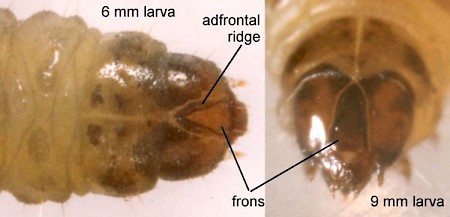Dichrorampha consortana

49.312 BF1280
Dichrorampha consortana
Stephens, 1852
Wingspan 9-12 mm.
The adult resembles several other brown Dichrorampha spp.. It is usually, but not always, smaller and darker than D. acuminatana, and has relatively broader forewings than that slender commoner species. Dependable identification of adults is obtained by expert examination of specimens and dissection of genitalia.
D. consortana is widespread in England, but very local and rather uncommon. There are a few records from Wales, Scotland and Ireland. It should be sought flying around its foodplant , oxeye daisy (Leucanthemum vulgare), on dry basic grassland and road verges in afternoons from mid June to August.
Larvae of five other species of Dichrorampha feed in the rootstock of oxeye daisy, but the larval stage of D. consortana is easily recognised, as it is the only one to feed in the upper stem and flower bud.
Pupation in June is either in the stem, or an earthen cocoon.
Larva: (description Ian F. Smith)
Foodplant: Leucanthemum vulgare. In late April and early May, affected plants can be detected by the one or two thickened leaves, near the flower bud, curled upwards to resemble pods. The curled leaves may contain frass expelled by the 6 mm to 9 mm larva in the adjacent stem and flower base. In late May and early June, the slight swelling of the stem is more noticeable, frass may be more evident around the aborted main flower bud, and the stunted main stem is outgrown by several lateral shoots bearing undersized flowers.
Early instar larva
Length: 6 mm and 9 mm described, early May.
Head: Dark brown, paler at anterior. Adfrontal ridge distinctly darker. Vertical triangle, epicranial suture and frontal cleavage line pale, translucent. Frons lighter (6 mm larva), or darker (9 mm larva), than epicranium. Posterior of head thinly edged black. Black posterolateral mark. Mouthparts reddish brown. Stemmatal area black.
Prothoracic shield: Transparent shiny light brown. Head visible when retracted below shield. Some irregular dark blotches, including a large lateral blotch and two blotches either side of the narrow yellowish medial dividing line.
Thoracic legs: Transparent, yellowish, paler than body. Thin pitchy black shallow 'V' line across anterior of base. Fainter dark line across posterior of base.
Body: Dingy yellow. Shagreened. Translucent; gut shows grey in thorax, becoming dull orange in abdomen, most clearly visible through transparent dorsal line. Gonads visible in segment A5, and grey frass, if present, visible in A9 and A10.
Spiracles: Dark brown peritreme.
Pinacula: Large, pale grey with a fine dark setal spot.
Setae: Transparent colourless.
Anal segment: No anal comb. Anal plate coloured as body, lacking shagreen. Weakly sclerotised. Appears dark if frass in transit. 9 mm larva has transverse row of about twelve reddish brown dots across anterior and a few scattered dots.
Prolegs: Coloured as body. Crochets pale reddish brown in a single circle, except anal leg has single transverse row of crochets.

 UKMoths
UKMoths 








